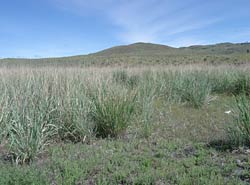
Solonetzic soils are often found in grassland ecosystems
Solonetzic soils (or Natric subgroups in USDA Soil Taxonomy) occur in the same ecozones as Chernozemic soils. These soils are characterized by low (exchangeable) calcium to sodium ratio (the ratio is 10 or less). The higher content of exchangeable sodium may be either due to high sodium content in the parent material (e.g. shale) or sodium could have been deposited in the soil profile by groundwater. The diagnostic horizon of Solonetzic soil is a Bn (or Bnt), and this horizon is very hard when dry and it swells and becomes relatively impermeable when wet.
There are four great groups of the Solonetzic order. Three of them represent an idealized evolutionary sequence, which begins with soil with a Bn horizon (Solonetz great group). Sodium-enhanced clay translocation begins, creating an Ae and a Bnt horizon (Solodized Solonetz great group). When the upper Bnt is altered by the weathering processes outlined above, the soils are placed into the Solod great group. In soils formed in parent material high in clay (typically > 60% clay) the Ae/Bnt sequence may be weakly expressed and those soils are classified into the Vertic Solonetz great group.
Solonetz Great Group
These soils have a solonetzic Bn horizon and either no Ae horizon or Ae that is ≤ 2 cm thick.
Solodized Solonetz Great Group
Soils of this great group have an Ae thicker than 2 cm and an intact Bnt or Bn.
Solod Great Group
These soils also have an Ae thicker than 2 cm as well as a distinct AB or BA horizon (formed by disintegration of Bnt horizon).
Vertic Solonetz Great Group
These soils have any of the features listed above plus a slickenside horizon within 1 m of the soil surface.